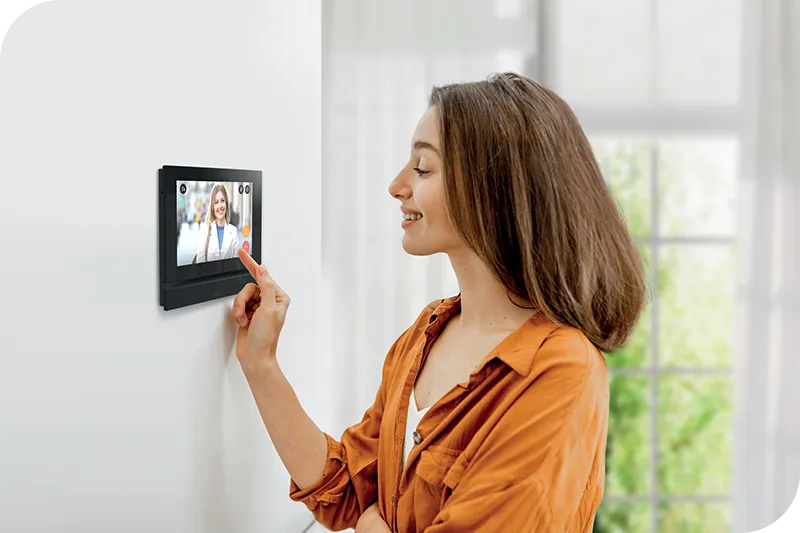Quality within Your Budget: a Guide to Indoor stations
 Camilla Ashdown, 10. 11. 2023 | 7 min read
Camilla Ashdown, 10. 11. 2023 | 7 min read
Do you have an upcoming project and want to make sure you’re choosing the right indoor station for your budget? Let’s delve into all the different types – and find the perfect one for you!

Audio-only or video-enabled units? What’s the difference between IP and analogue video communication? What do you need for your target market, and what can you get within your budget? Let’s start with the basics: 2wire vs. IP indoor stations.
2wire Technology: Classic but Limiting
2wire technology relies on a single pair of wires (typically used in older analogue systems) to transmit both power and data between the indoor station and the outdoor unit (such as an intercom, or doorbell). It’s often used in legacy systems and smaller-scale projects due to its simplicity and cost-effectiveness. The transmission of signals is typically in analogue format and can be unreliable – more on that later!
Pros
- Cost-Effective: The simplicity of 2wire systems often translates into lower installation and equipment costs – and they are often already part of the existing access system in older buildings.
- Simplicity: Installation and setup are straightforward, making it suitable for less complex projects.
Cons
- Limited Scalability: 2wire systems may not scale well for larger installations, as they rely on a single pair of wires for communication.
- Basic Features: These systems often offer basic communication and do not support other advanced features that are often demanded in modern-day projects.
- Lack of Compatibility: They may not integrate very well – limiting the power and capabilities of the installation significantly. With IP, you can integrate with security systems, home automation platforms, and so on – which offers your customers a complete solution.
IP Technology: Versatility and Advanced Features
IP (Internet Protocol) technology represents a more advanced and versatile approach to indoor stations.
IP technology leverages standard network infrastructure and protocols to transmit data, including audio and video, over Ethernet cables or Wi-Fi. It is compatible with modern IP-based access control systems and is suitable for projects of various sizes, from residential complexes to large commercial buildings – even small single villa projects can benefit from IP technology!
Pros
- Enhanced Connectivity: IP systems utilize existing network infrastructure, allowing the indoor station to be scalable and easy to integrate with other IP-based devices.
- High-Definition Video: IP indoor stations can deliver high-quality video, providing visual verification of visitors.
- Advanced Features: They often come with advanced features such as remote access, integration with mobile apps, and compatibility with modern access control systems.
Cons
- Cost: IP indoor stations are generally more expensive than 2wire, due to the need for network infrastructure and advanced features
- Complexity: Installation and configuration of IP indoor stations may require more technical expertise, particularly in the case of enabling them with advanced features.
If you want to use IP technology, try to choose a provider that prioritizes installers’ and building managers’ convenience. The My2N Management Platform is one example of this – operating on a cloud-based structure, it allows you to configure devices remotely – and the interface is designed to be as user-friendly as possible.
Audio Only vs. Video: Seeing is Believing!
Indoor stations can provide either audio-only or video communication capabilities. But which should you choose? It depends on the project and its needs, however, there are some remarkable benefits to giving residents (or offices) video communication.
Audio-Only Indoor stations
Pros
- They are usually simple devices that therefore run at a lower price point.
- Suitable for less security-critical environments or basic installations.
- Suitable for users that may struggle with video communication – such as the elderly.
Cons
- Audio-only units offer less clear communication with visitors.
- There is no visual verification possibility.
- Often fails to meet modern standards.
Video-Enabled Indoor stations
Pros
- Enhanced security thanks to visual verification of visitors.
- Useful in monitoring other areas of the building: i.e. the entrance via the IP intercom’s camera feed or other areas where there is an IP camera installed (providing the indoor station can connect to them!).
- Can enable other advanced features such as DoorViewer, a new feature added to the 2N® Indoor View: the ability for indoor stations to act as a spy hole.
Cons
- Typically run at a higher price point.
- Increased network bandwidth usage.
Analogue vs. IP: Is all video created equal?
No! If you’re going to install a video indoor station, IP is more often than not, the best option.
IP systems use standard network infrastructure and protocols to transmit data, which includes high-definition video and audio. Analogue video, however, tends to have lower resolution and the signal quality can be affected by interference, leading to potential degradation in video and audio quality.
IP video also typically means high-definition video quality with superior clarity and detail: and the IP camera from which the indoor station gets its feed can offer features like wide-angle lenses, zoom capabilities, and night vision for enhanced visibility.
Analogue video, however, is often characterized by lower resolution, which may result in less detailed and less clear images. It therefore won’t provide the same level of security that IP video offers as the images will be less detailed, making visual verification somewhat unreliable.
The material world: luxury finish vs. affordable design
Luxury materials
Indoor stations designed for the high-end market are often made from premium materials such as glass, stainless steel, aluminium, and high-grade plastics. The use of these materials results in a premium look and feel that matches the level of high-spec interiors. It also means that the indoor station will benefit from enhanced durability: better materials mean more resistance to wear and tear.
However, these indoor stations are often more expensive and may require specialized care – it could well be that your project doesn’t necessitate such a high-spec finish. So what suits this?
Cost-effective choices
Due to its low cost, plastic is a more cost-effective choice. It’s also lightweight and easy to install – making it the best choice for budget-conscious projects.
Plastic-constructed indoor stations can look, well, cheap! And even for mid-range projects, that can be something to avoid. So, make sure you choose a unit that, whilst being constructed from cheaper materials, still prioritises good, simple design and robust durability.
Wrapping it up: High-end vs. Mid-range Indoor stations
Indoor stations designed for the high-end market can reach amazing heights in terms of what they can do. As the price point is higher, it gives manufacturers room to play with top-of-the-line materials and cutting-edge technology.
Premium indoor stations can benefit from the following:
- Pinch-to-zoom: the ability to use two fingers to zoom in for greater detail on visitors’ faces or ID badges (in the same method as zooming on a touchscreen phone).
- Integration with home automation platforms to make the indoor station the central control panel for the home: controlling.
- Ability to connect to IP video intercoms and other IP security cameras stationed around the building for home surveillance.
- Luxury craftsmanship and award-winning design.
However all this can come at a premium price tag, and sometimes these great features exceed the requirements of smaller, mid-priced projects.
Indoor stations developed for the mid-range market, however, need to create a balance of affordability and functionality.
Whilst they may not be as luxurious as high-end units and lack some advanced features – the right one will balance the best of both worlds to be suitable for a wide range of interiors, and have decent performance and quality, all without the premium price tag. Seems impossible, but it can be done!
Can you get the best of IP at a lower price point?
As mentioned, IP capabilities typically come at a higher price point. This can be a pain since the demand for more affordable housing is on the rise – but residents’ demands are also rising. Everyone wants good quality for less nowadays!
That’s why an indoor station such as the 2N® Clip is a fantastic choice. As a company, 2N knows a thing or two about quality (our premium units are second to none in terms of design and features) – so we designed the 2N® Clip to make sure we could offer the mid-range sector the same quality without the high-end price tag.
The 2N® Clip offers residents high-quality IP video, a simple yet aesthetic design from affordable materials, and can be integrated easily into an existing IP intercom solution – all at a price point that suits mid-range projects perfectly!
Of course, if your budget is more flexible and you want the best of the best - an indoor station such as the 2N® Indoor View is the unit for you! It supports all the advanced features mentioned above, and won awards for design, too. Which you choose simply depends on your needs.
Overall, it’s clear that indoor stations play a vital role in enhancing security, communication, and convenience for residents. By understanding the nuances between 2wire and IP units, audio and video capabilities, material choices, feature sets, and cost ranges, you can make informed decisions when selecting indoor stations for your projects.